The Small Five animals of Africa
The Small Five - Another "must-see" to add to your safari to-do list
Visitors to South Africa are always keen to get a photograph of one of South Africa's celebrated Big Five animals: elephant, lion, rhinoceros, buffalo, and leopard. Conjuring up magical mental images of the wild African Bush, the Big Five are truly magnificent animals, and seeing all five on a safari is a major privilege.
However, whilst these are all magnificent animals, South Africa's Small Five animals makes an excellent addition to your South African "must-see" list. The Small Five (also known as the Little Five), are sometimes quite elusive little critters, and seeing all of the Small Five on a safari is as much of an accomplishment as seeing the Big Five or the Ugly Five.
(Geochelone Pardalis)
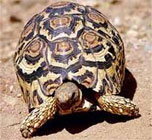
Definitely not the fastest animal on land, the Leopard Tortoise is certainly a fashionable creature.
Sporting a striking black and yellow spotted exterior shell, the Leopard Tortoise is one of the largest breeds of tortoise in this part of the world. A mature leopard tortoise can weigh over 23 kilograms, with a shell circumference of up to one meters.
As with most animal species, the leopard tortoise males are larger than the females.
(Scrabaeinae dynastinae)
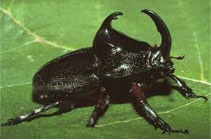
Like it's counterpart in the Big Five, the Rhinoceros Beetle has formidable "horns" on its head. Male Rhinoceros beetles are generally more aggressive than females, but both have horns. The horns are used to dig, climb, and mate.
The larval stage of the Rhino Beetle's life cycle can be very long and is very time consuming. If you happen across a adult Rhino Beetle, give it the respect it deserves. These giants of the insect world has come a long way.
(Myrmeleontidea)
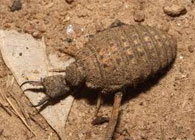
The Ant Lion is a not-too-often seen familiar feature in the bushveld. Ant Lions dig funnel-shaped holes in soft, dry sand. These "funnels" helps the Ant Lion trap unsuspecting ants stumbling into the holes.
If you do run across a Ant Lion hole, ask your safari guide to show you how the
Ant Lion pounces on it's pray, by gently simulating an ant falling into the funnel
and running around.
In the advanced stages of an Ant Lion's life cycle, they boast wings and resembles a dragonfly, albeit with serious problems at taking flight!
The Ant Lion in the little funnel holes are in fact Ant Lion larvae, which digs itself into the earth in search of dry, warm spots.
(Elephantulus Myurus)
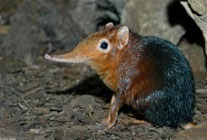
The Elephant Shrew is an insectivore that lives in arid lowlands, rocky outcrops and savannah grasslands. Elephant Shrews are named for their elongated snouts.
They grow to a length of 250mm, with an average weight of 60 grams. Elephant
shrews feed on insects, fruit, seeds and nuts.
In part due to their small size, and the fact that they are considered a scrumptious
treat by snakes and raptors, Elephant Shrews are extremely shy and wary.
Chances of spotting them are very slim indeed.
(Bubarlornis Niger)
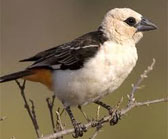
The Buffalo weaver is found in parks and game reserves all over South Africa. These social birds hold true to their name - they are weavers of note. Buffalo weavers build their nests in the forked branches of trees, and are a rather busy and noisy bunch.
Their tendency for creating huge nests from coarse grasses and untidy twig structures, often alert you to their presence before you even hear them happily and noisily going about their business.

 Map of South African Attractions
Map of South African Attractions  South African Attractions with GeoCaches
South African Attractions with GeoCaches